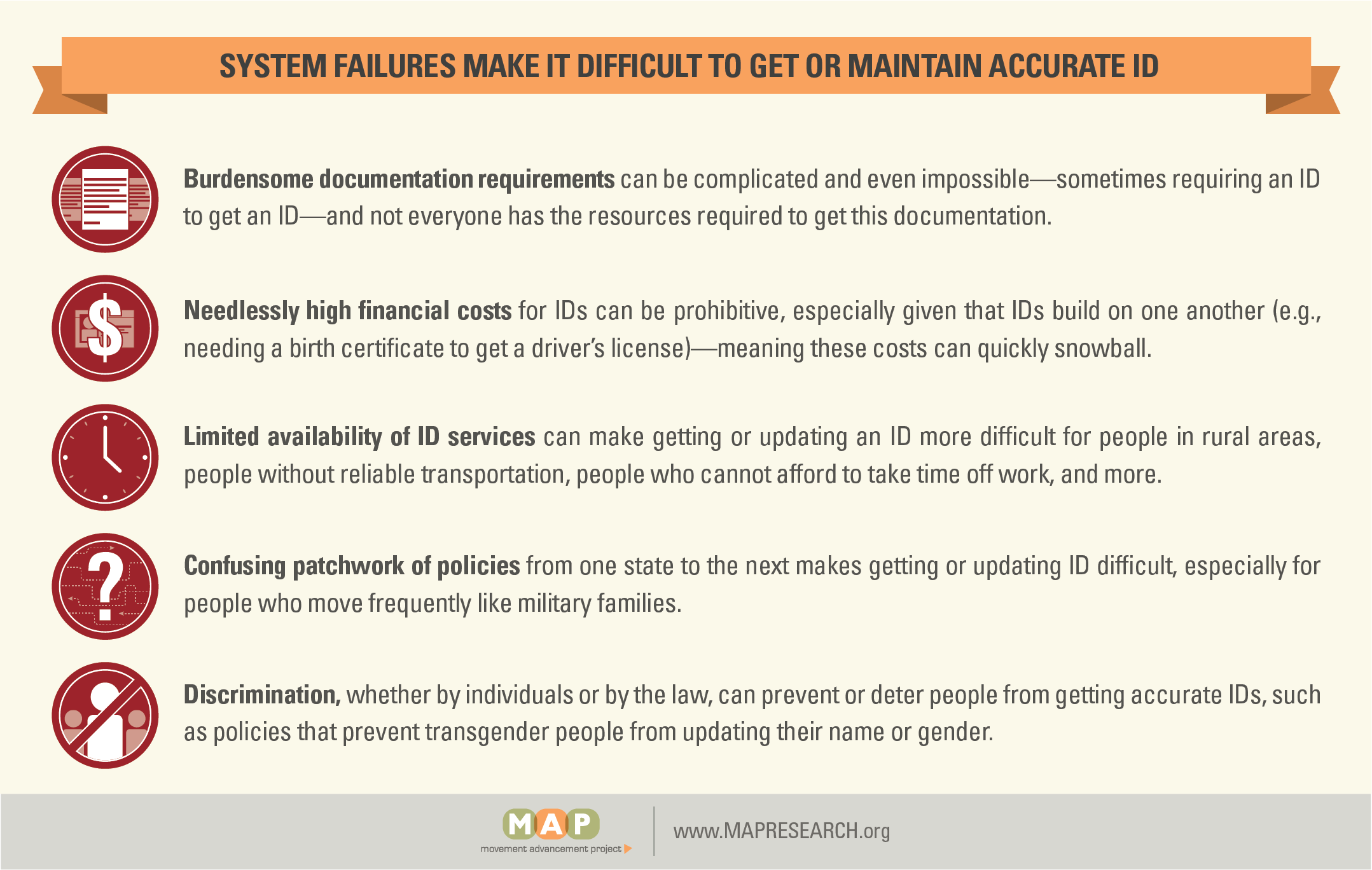
How Barriers to ID Impact Different Communities and Restrict Democracy
BY MOVEMENT ADVANCEMENT PROJECT
Identity documents (IDs), like driver’s licenses and birth certificates, are common and vital parts of everyday life and civic engagement. Yet, clear system-level failures make it too difficult for many people to get and maintain accurate IDs. These challenging obstacles can turn to real harm for people of all backgrounds—and especially for groups that face ongoing discrimination and marginalization.
Major roadblocks to IDs, however, can be avoided and fixed. MAP’s report, The ID Divide: How Barriers to ID Impact Different Communities and Affect Everyone, and its accompanying fact sheets highlight clear, achievable policies that make it possible for people to acquire IDs and equally participate in civic life.
An Uneven Landscape and Roadblocks to Accessing ID
IDs are regularly required in day-to-day life — from driving, to opening a bank account, getting a job, and, increasingly, voting. Yet, roughly one in eight adults in the United States (an estimated 30 million people) lack a driver’s license. What’s more, an estimated 15-18 million adults in the United States—more than the total population of Pennsylvania—do not have access to documents proving their birth or citizenship, which are often necessary to obtain an ID. These staggering numbers can be explained by system-level failures, which have created obstacles to getting and maintaining accurate IDs for many people.
Identity documents typically build upon each other. If a person lacks their birth certificate, for instance, it is harder to get a driver’s license. If they lack a driver’s license, it is harder to prove their identity to get an official copy of their birth certificate. These circular challenges and other barriers—including burdensome documentation requirements, prohibitive financial costs, limited availability of ID services, a confusing patchwork of policies, and discrimination—make it all the more difficult to acquire an ID.
While approximately 12% of U.S. adults nationwide lack a valid driver’s license, we also know that who has an ID varies across certain communities. For example, an estimated 21% of Black adults and 68% of transgender people don’t have a valid, accurate driver’s license. These disparities are in part due to the ongoing obstacles marginalized groups encounter when attempting to acquire an ID.
- In Black communities, many factors create obstacles to ID, including discriminatory policing practices, like searches and fines, that negatively impact Black adults and result in licenses being suspended at disproportionate rates. Historical factors, like legal segregation’s routine denial of hospital access, have created generational barriers to birth certificates among older Black adults.
- Transgender and nonbinary people navigate complicated state policies to acquire accurate IDs. Processes for getting a legal name change or updating a gender marker vary from state to state (and even from one form of ID to another) and often, this process can be needlessly expensive, which is a particular challenge for the estimated 30% of transgender people who live in poverty. Transgender and nonbinary people may also experience discrimination when they try to update their IDs: in a survey from the Center for American Progress, 66% of transgender people said discrimination had an impact on their ability to update their documents in the past year alone.
These are just a few examples of how system-level failures and discrimination directly harm and deter certain communities from acquiring IDs. MAP’s report and supplemental fact sheets also outline the obstacles facing Indigenous and Native communities, immigrant communities, low-income communities, people experiencing homelessness or housing insecurity, and formerly incarcerated people.
Barriers to ID, Barriers to Voting
Our society’s broad reliance on IDs means that when people cannot obtain an accurate ID, it severely limits their ability to participate in society—including in a cornerstone aspect of democracy: voting. Given the system-level failures described above, which create barriers for people to even get an ID, it becomes increasingly difficult to exercise the right to vote in states where ID requirements are in place.
Current ID requirements for in-person voting affect a sizable proportion of voters. Nearly one in four voting-eligible Americans live in a state that requires a form of ID to vote, and 11 states require photo IDs to cast an in-person ballot without alternatives. In some states, ID is also required for mail voting; in Florida, for example individuals must provide a driver’s license or social security number to request a vote by mail ballot. Voters in the state who do not have this information in their voter registration file may be unable to vote by mail.
New voter ID legislation is also on the horizon in several states. Nebraska’s legislature is working to implement a ballot measure passed last year that called for stricter ID laws in the state, and new voter ID laws are set to be implemented for elections this year in North Carolina and Ohio.
Extensive research and robust evidence show that strict photo ID laws create significant obstacles to voting can lower voter turnout, and in some cases can directly prevent people from exercising their right to vote. These hurdles make it harder for everyone to vote, but research shows that Black voters and transgender and nonbinary voters are disproportionately impacted by these requirements. Strict voter ID laws harm Black voters and other voters of color through rejected registrations and ballots, decreased voter turnout, and much more. For transgender and nonbinary people, lack of accurate ID can pose problems within and beyond the polls. Nearly half of transgender people in states with voter ID laws lack an ID that matches their name and/or gender identity, exposing them to substantial barriers to voting and even potential disenfranchisement.
Recommended Solutions
The harms associated with current ID policies and laws in the U.S. affect everyone, and they are exacerbated in certain communities due to high costs, discrimination, a limited availability of ID services, and more. In addition to disrupting day-to-day life, a lack of ID also severely limits one’s participation in democracy.
In response to these challenges, MAP’s The ID Divide offers system-level solutions and specific recommendations to reduce obstacles and improve access to IDs for everyone. Overall, policymakers should carefully determine when an ID is truly necessary and when requiring it might limit access to basic needs and essential services. Additional recommendations include ways to:
- Simplify documentation requirements and processes
- Reduce the needlessly expensive costs of obtaining and updating IDs
- Increase access to ID services and IDs themselves
- Set nationwide standards for ID accessibility for all
- Reduce discrimination in ID policies and administration
Identity documents can serve important functions, but they should not and must not be an obstacle to accessing basic needs and services or participating in civic and daily life. MAP’s report shows there are clear, achievable paths forward for promoting public safety and good governance while still ensuring the rights of people to move freely, have their needs met, and have an equal opportunity to participate in civic and everyday life.
To learn more about the landscape of policies related to ID documents, plus specific community-by-community fact sheets outlining challenges and obstacles to ID, visit MAP and read our full report.
This post also appears on the Movement Advancement Project’s Democracy Maps blog, available here.
____________________________________________________________________________________
VoteRiders is working nationwide to address the crisis that voter ID laws are creating in our democracy. We provide free information and assistance to all eligible voters who need help securing identification and/or underlying documents. We also inspire and support partner organizations, local volunteers, and communities to sustain voter ID education and assistance efforts.
Many organizations don’t have the resources to answer voter ID-related questions or provide personal assistance to people who need identification. We can help fill that gap! Partner organizations can use our free tools and services to address ID issues in whatever way makes the most sense for their community.
Learn more about our partnership program and how we can work together to protect the right to vote!



